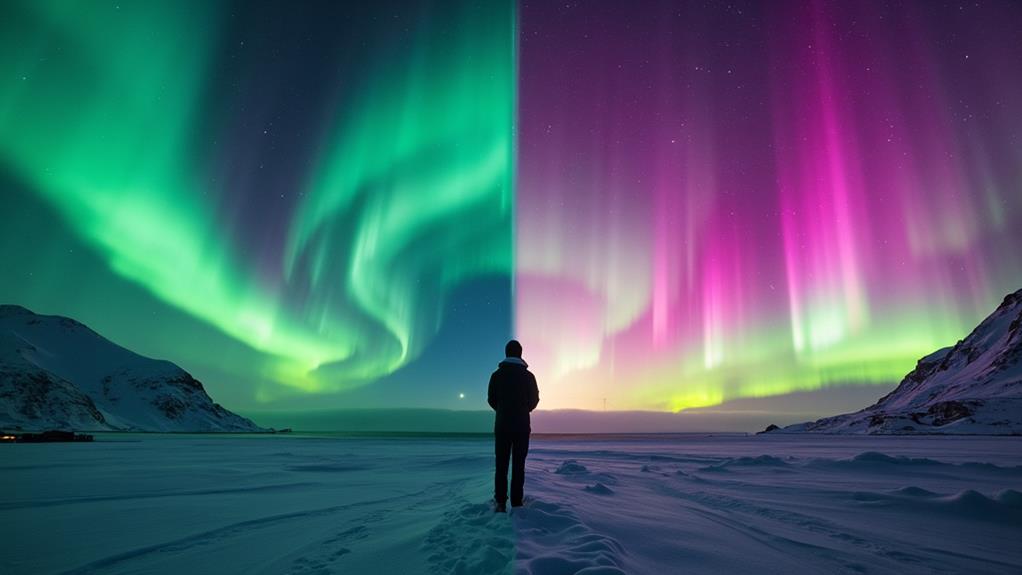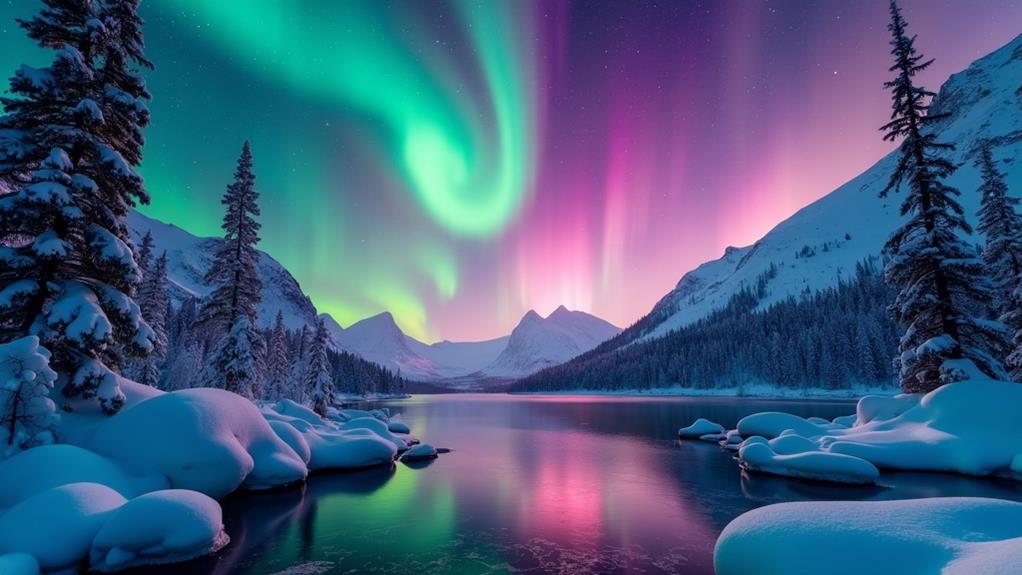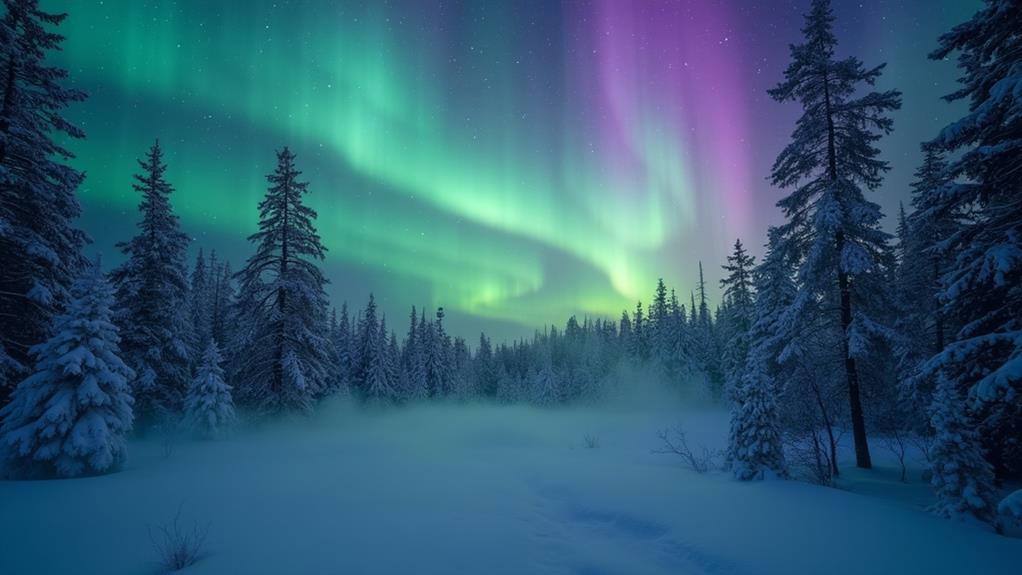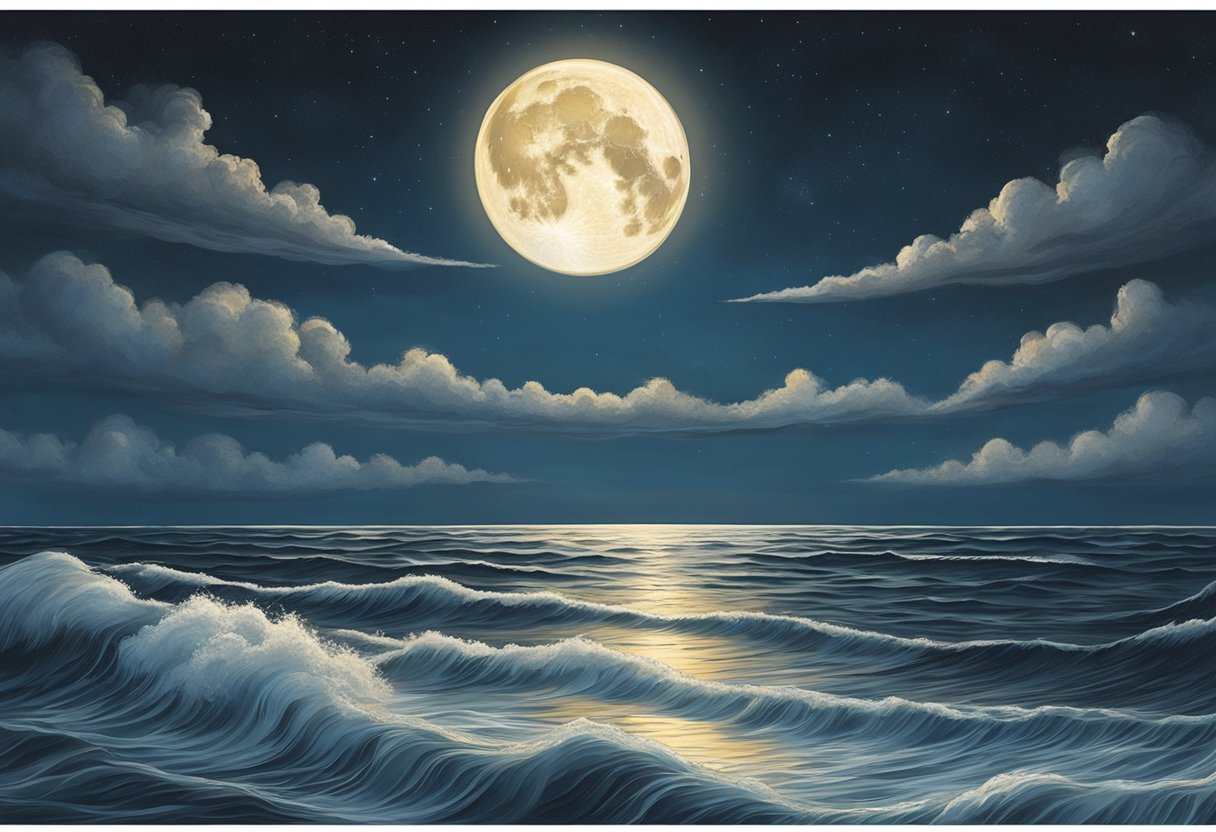The Role of Earth’s Magnetic Field in Creating the Aurora Borealis
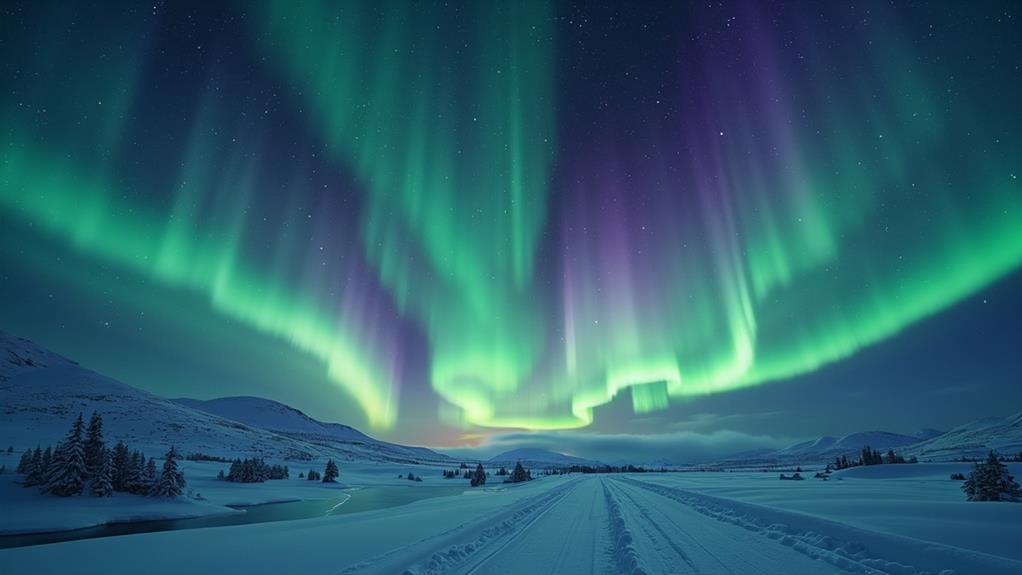
Ever wondered how Earth's magnetic field contributes to the mesmerizing Aurora Borealis? This invisible shield not only safeguards us from harmful solar wind but also orchestrates one of nature's most stunning light displays. When charged particles from the Sun are steered by this magnetic field toward the polar regions, they collide with atmospheric gases, producing vibrant colors in the night sky. What determines these colors, and when is the best time to witness this spectacle? Let's delve into these fascinating details.
The Function of Earth's Magnetic Field
Earth's magnetic field acts as a crucial shield for our planet by deflecting charged particles from the solar wind, thereby preventing significant atmospheric erosion. The magnetic field lines form loops around the North and South Poles, guiding these particles toward the polar regions. When the solar wind interacts with Earth's magnetic field, charged particles are accelerated along these magnetic pathways.
As these particles travel along the magnetic field lines, they collide with atmospheric gases, causing these gases to emit light and create the phenomenon known as the aurora borealis. Auroras typically occur at altitudes between 60 and 400 miles above the Earth's surface, where electrons and other particles excite oxygen and nitrogen atoms.
The patterns and intensity of the aurora borealis are influenced by variations in the strength and orientation of Earth's magnetic field. During periods of increased solar activity, these displays can extend farther south, making them visible to more people. This dynamic interaction between the solar wind and Earth's magnetic field not only results in breathtaking natural light shows but also underscores the essential role our planet's magnetic field plays in protecting us from space weather.
Solar Wind and Charged Particles
The solar wind, composed of charged particles such as electrons and protons, travels from the Sun at high velocities. Upon reaching Earth, these particles interact with the planet's magnetic field and are directed toward the polar regions. This interaction leads to collisions with atmospheric gases, producing the stunning light displays known as the aurora borealis in the Northern Hemisphere and aurora australis in the Southern Hemisphere.
Composition of Solar Wind
Solar wind, a stream of charged particles primarily composed of electrons and protons, originates from the Sun's outer layer, known as the corona. These particles travel at speeds of about 1 million miles per hour (approximately 400 kilometers per second) and can reach Earth in roughly 1 to 3 days. The solar wind's intensity varies due to solar activity, such as solar flares and coronal mass ejections (CMEs).
When these charged particles encounter Earth's magnetic field, they are funneled towards the polar regions. Here, they interact with atmospheric gases, creating mesmerizing aurora displays. The composition of the solar wind, including its density and speed, plays a crucial role in determining the intensity and frequency of these auroras.
Key points to note:
- Speed: Solar wind travels at about 1 million miles per hour.
- Composition: Mainly electrons and protons.
- Solar Activity: Stronger emissions occur during solar flares and CMEs.
- Auroral Impact: Directly affects the intensity of aurora displays.
- Polar Regions: Where particles are directed by Earth's magnetic field.
Understanding the solar wind's composition helps appreciate the dynamic and beautiful auroras gracing our skies.
Interaction With Atmosphere
Charged particles from the solar wind collide with Earth's atmospheric gases, igniting the mesmerizing aurora borealis. As these high-energy particles approach Earth, they are guided by the planet's magnetic field, which acts as a protective barrier. This magnetic field directs the charged particles toward the polar regions, where auroras are predominantly visible.
When these energetic particles enter the atmosphere, they interact with gases like oxygen and nitrogen, transferring energy and causing these gases to emit light. Oxygen at lower altitudes produces the vivid green color commonly associated with the aurora, while nitrogen can create blue and purple hues. The aurora's patterns align with Earth's magnetic field lines, resulting in dynamic and visually striking displays in the night sky.
During periods of heightened solar activity, such as coronal mass ejections (CMEs), the intensity and visibility of the aurora borealis increase. These events enhance the influx of charged particles, making the aurora more colorful and widespread. Understanding this interaction between the solar wind, Earth's magnetic field, and atmospheric gases allows for a deeper appreciation of the aurora borealis and its connection to solar activity.
Particle Collisions and Light Emission
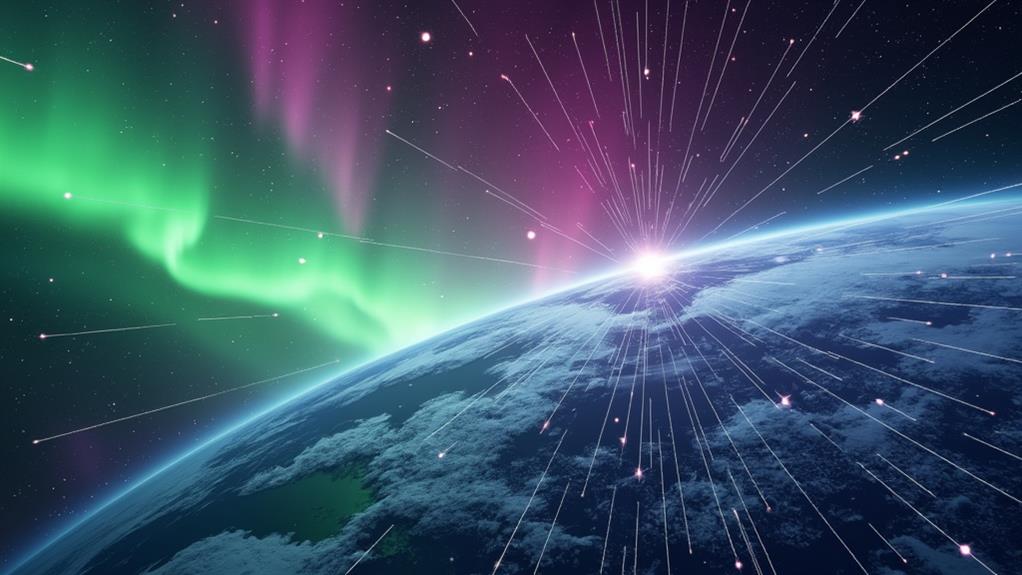
When solar wind particles collide with Earth's atmospheric gases, they create the mesmerizing spectacle known as the aurora borealis. These charged particles, primarily electrons and protons from the sun, are directed by Earth's magnetic field towards the poles. As they travel, they collide with atoms and molecules in the atmosphere, primarily oxygen and nitrogen, leading to particle collisions and subsequent light emission.
This phenomenon occurs at altitudes ranging from 60 to 400 miles above the Earth's surface. When these particles collide with oxygen atoms, they typically produce green light at lower altitudes and red light at higher altitudes. Nitrogen molecules contribute to purple, blue, and pink hues, depending on the energy levels and altitudes involved. The intensity and variety of the aurora borealis are closely tied to solar activity; stronger solar storms result in more vivid and extensive displays.
Key Points:
- Charged particles from the sun (solar wind).
- Earth's magnetic field directs these particles toward the poles.
- Particle collisions with oxygen create green and red emissions.
- Nitrogen interactions produce purple, blue, or pink light.
- Higher solar activity leads to brighter auroras.
Understanding these collisions and light emissions helps demystify the incredible natural light show that is the aurora borealis.
Colors of the Aurora Borealis
Witnessing the aurora borealis is akin to observing a natural light orchestra, where each color has a distinct role. The vivid colors result from charged solar particles colliding with gases in Earth's atmosphere. Green, the most prevalent color, appears when these particles interact with oxygen at lower altitudes, illuminating the sky with a spectacular green glow.
Red auroras, which are less common, form at higher altitudes and also originate from oxygen emissions. These red lights often occur during periods of high solar activity, adding an extra layer of drama to the celestial display. Nitrogen contributes to purple, blue, and pink hues, which emerge under varying altitudes and conditions, making the aurora borealis a dynamic and ever-changing phenomenon.
The spectrum of colors is determined by the type of gas involved and the energy level of the impacting solar particles. Additionally, the brightness of the surrounding sky affects visibility, with darker skies enhancing the appearance of the auroras. Each hue is a result of the intricate interaction between charged particles and atmospheric gases, culminating in one of nature's most mesmerizing displays.
Best Times to See Auroras
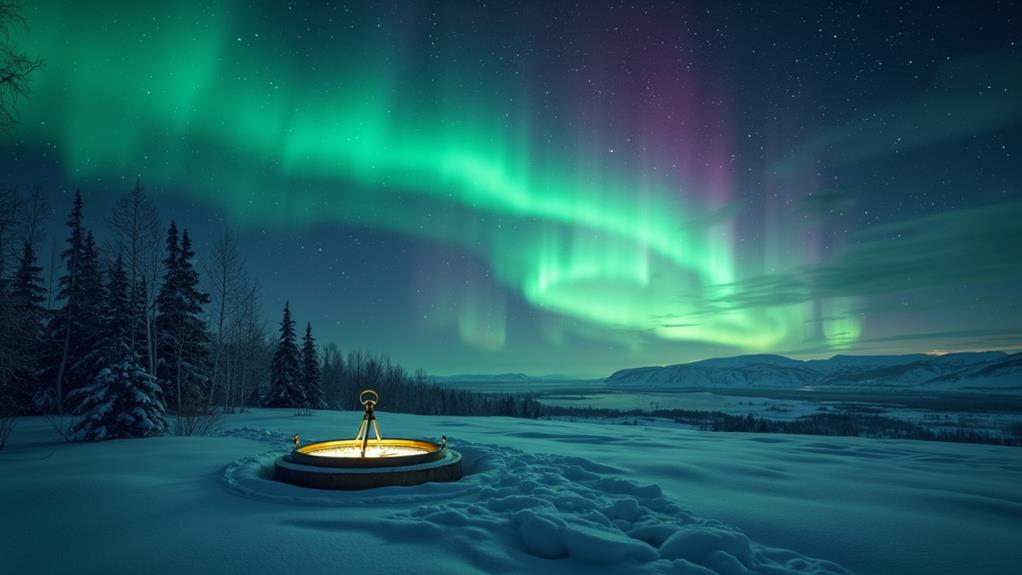
Catching a glimpse of the aurora borealis can be a life-changing experience, and timing is crucial for maximizing your chances. The best times to see the auroras are from late September to early April, with peak visibility during the spring and fall equinoxes. During these periods, solar activity is typically higher, enhancing your chances of witnessing these stunning displays.
For optimal visibility, focus on the hours between 5 PM and 2 AM. Regions within the Auroral Ovals, particularly in northern Canada and parts of Alaska, offer prime viewing opportunities due to their proximity to the magnetic poles. Winter months, with their longer nights, further improve visibility, making it easier to spot auroras against the dark sky.
To make your aurora hunting more effective, keep in mind:
- Late September to early April: Best overall timeframe.
- Spring and fall equinoxes: Higher solar activity.
- 5 PM to 2 AM: Peak hours for visibility.
- Northern regions: Especially northern Canada and Alaska.
- Increased solar activity: Watch for geomagnetic storms, which can extend visibility further south.
Tips for Viewing and Photography
To maximize your aurora borealis viewing and photography experience, follow these essential guidelines:
Choose the Right Time and Location
Head to northern Canada or parts of the U.S. during the prime months from August to May. These regions and timings offer optimal conditions for witnessing the northern lights against a dark night sky.
Monitor Solar Activity
Keep an eye on solar activity forecasts. Increased solar activity and coronal mass ejections (CMEs) enhance aurora intensity and visibility. Utilize websites and apps dedicated to tracking solar storms for real-time updates.
Photography Tips
- Use Long Exposure Settings: Capture the vibrant colors and movements of the auroras with long exposure settings.
- Tripod and Manual Camera Settings: A sturdy tripod and a camera with manual settings are essential.
- Avoid Light Pollution: Seek out dark skies away from city lights to ensure the auroras are visible in their full glory.
Prepare for Cold Conditions
Dress warmly, as viewing auroras often involves long waits in cold environments. Wear layers and thermal clothing to stay comfortable.
Scientific Insights and Research
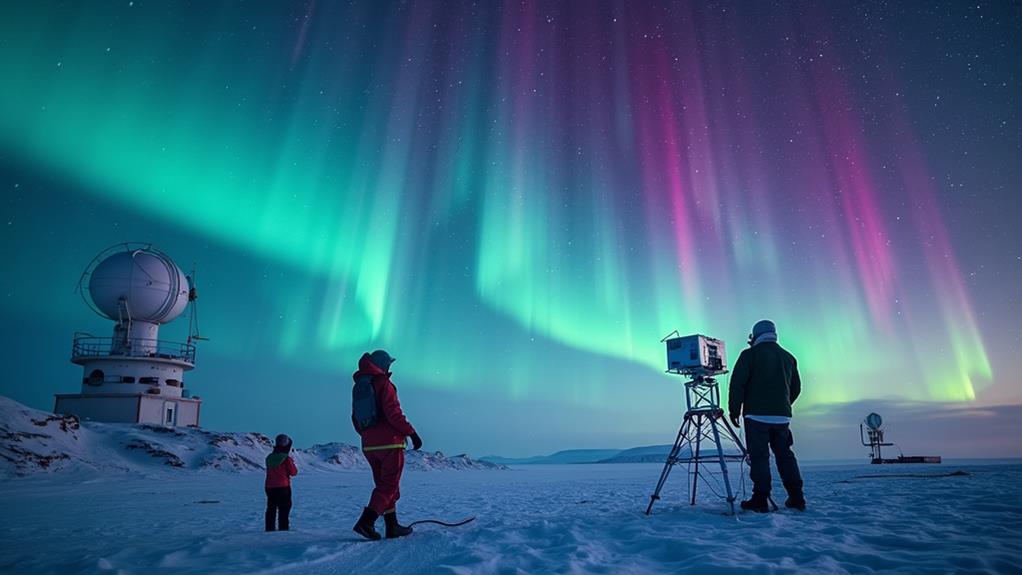
The Earth's magnetic field serves as a protective barrier, directing solar wind particles towards the poles, where they create auroras. These captivating light displays occur when high-energy particles from the Sun collide with atmospheric gases. NASA's THEMIS mission has significantly enhanced our understanding of these interactions, shedding light on the complex dynamics between solar activity and Earth's magnetosphere, which in turn influences space weather.
Dynamics of Magnetic Fields
Understanding the dynamics of magnetic fields is crucial for comprehending how the aurora borealis forms and behaves. Earth's magnetic field acts as a protective shield, redirecting charged solar particles towards the poles. During solar storms, magnetic field lines stretch and snap back, guiding electrons that produce the visible light of the aurora borealis when they collide with atmospheric gases.
Key points to reflect on include:
- Earth's magnetic field: It deflects solar particles toward the poles, creating auroras.
- Solar activity: Intense auroras often occur during coronal mass ejections (CMEs), which significantly alter magnetic field dynamics.
- Satellite data: Missions like THEMIS show auroras moving in sync with magnetic field changes.
- Magnetic field oscillations: These can cause variations in aurora brightness, with increased activity roughly every six minutes.
- Magnetosphere behavior: Research highlights the correlation between magnetic field line movements and auroral phenomena.
Studies reveal that auroras are most intense during heightened solar activity, such as CMEs, which greatly alter magnetic field dynamics. Satellite observations have demonstrated that auroras sync with changes in magnetic field strength and orientation, providing valuable insights into the behavior of Earth's magnetosphere. The oscillation of magnetic field lines causes variations in aurora brightness, correlating with periods of increased auroral activity.
Auroras and Space Weather
The study of auroras and space weather provides deeper insights into these mesmerizing light displays, grounded in the dynamics of magnetic fields. Auroras are primarily caused by interactions between charged particles from the sun and Earth's magnetosphere. These particles are funneled toward the poles along magnetic field lines, resulting in stunning light shows.
The intensity and visibility of auroras are closely linked to solar activity like solar flares and coronal mass ejections (CMEs). These solar events can enhance auroral displays and extend their reach further south. When particles from the sun collide with Earth's atmosphere, they can trigger spectacular auroras that move in sync with changes in magnetic field strength and orientation. Research using data from missions like THEMIS has demonstrated this dynamic behavior, providing valuable insights into space weather.
Monitoring auroral phenomena through satellite data and ground-based observations is essential for understanding the impact of solar activity on Earth's atmosphere and technological systems. Ongoing studies are critical for advancing space weather forecasting, helping to mitigate risks to satellites and communication systems from solar storms and their effects on the magnetosphere.
Public Engagement and Resources
Engaging the public in the awe-inspiring phenomenon of the aurora borealis has become more accessible thanks to a variety of dedicated resources and platforms. These initiatives keep you informed about auroral activities and offer educational materials. For example, the Canadian Space Agency leverages social media platforms like Facebook and Twitter to provide updates on potential auroral events. NASA also contributes significantly by sharing stunning aurora photography and informative content on YouTube and Instagram.
To ensure you don't miss out on these celestial displays, AuroraWatch UK offers real-time geomagnetic activity alerts, making it easier to anticipate and witness the auroras. Additionally, community projects like the Aurora Zoo invite public participation in collaborative research, allowing you to contribute to data analysis and gain a deeper understanding of auroras and their atmospheric interactions.
Here are some key resources to keep you engaged:
- Canadian Space Agency on Facebook and Twitter
- NASA's aurora content on YouTube and Instagram
- AuroraWatch UK real-time alerts
- Aurora Zoo collaborative research projects
- Aurora-focused newsletters for exclusive content
These resources ensure you stay connected and informed about this mesmerizing natural phenomenon.

